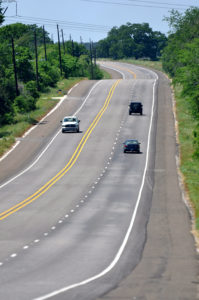
Texas A&M Transportation Institute (TTI) Graduate Research Assistant Ali Khodadadi recently published the article “Application of Different Negative Binominal Parameterizations to Develop Safety Performance Functions for Non-Federal Aid System Roads” in volume 156 (June 2021) of Accident Analysis & Prevention. The authors also include Subasish Das, TTI assistant research scientist; Yingfeng Li, Virginia Tech Transportation Institute research scientist; Dominique Lord, professor in Texas A&M University’s Zachry Department of Civil and Environmental Engineering; and Ioannis Tsapakis, TTI associate research scientist.
The article zeroes in on safety performance functions (SPFs) for non-federal aid system (NFAS) roads (e.g., local roads in rural or urban areas). Previous research focuses on high-volume roadways while not addressing NFAS road safety in depth. “NFAS roads account for more than 75 percent of U.S. total roadway mileage,” says Khodadadi. “Our study aims to bridge the literature gap by developing advanced, customized SPFs that best suit NFAS roads. The results can significantly improve NFAS safety assessments, as well as benefit any crash dataset requiring more flexible, innovative model structures.”
Khodadadi and the research team applied traditional negative binominal and zero-favored negative binominal (i.e., negative binominal-Lindley) models — the former for assessing variables and outcomes and the latter as a more flexible structure of the former — to 2014–2018 crash, roadway inventory and traffic volume data from Virginia. The negative binominal-Lindley models performed better than the traditional negative binominal models. “The improved SPFs can help determine high-risk crash sites and, thereby, prioritize how limited safety funds are spent to improve those sites,” notes Tsapakis. “The paper examined new methods that will generate much-needed safety discussions and planning.”

Khodadadi works in TTI’s Traffic Operations and Roadway Safety Division, and he is a Ph.D. student in transportation engineering in Texas A&M’s Zachry Department of Civil and Environmental Engineering. “Ali is a brilliant team member — evident in how he applied models using different formulations,” says Das. “And Ali’s paper bridges a research gap by developing advanced SPFs for a type of roadway underserved by past research.”
Khodadadi’s paper is part of the Safety through Disruption (Safe-D) University Transportation Center (UTC) project, Use of Disruptive Technologies to Support Safety Analysis and Meet New Federal Requirements. Two of the paper’s authors, Tsapakis and Das, are co-principal investigators. The Transportation Research Board recently awarded Tsapakis a topically similar project, NCHRP 07-30 Methods for Assigning Short-Duration Traffic Volume Counts to Adjustment Factor Groups for Estimating AADT.
“This Safe-D project demonstrates how new data sources for vehicle movement can supplement traditional traffic volume data collection efforts. Often, recent traffic counts on local roads are lacking or outdated,” says Associate Director Sue Chrysler. Chrysler is a human factors psychologist and senior research scientist in TTI’s Traffic Operations Group. “Using crowdsourced data provides a way for agencies to gather data across a long period of time and keep staff out of harm’s way by placing traffic counters in the roadway. This leveraging of disruptive technology while improving safety is what the Safe-D UTC is all about.”